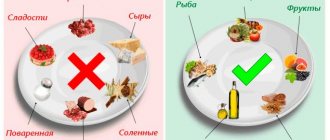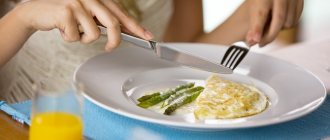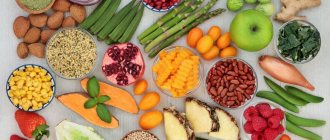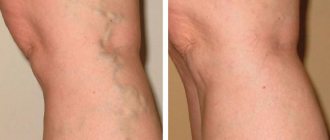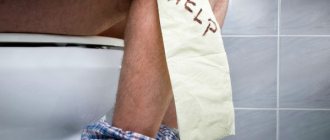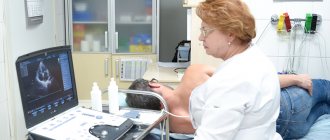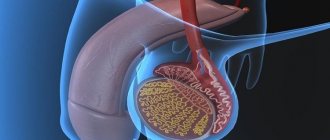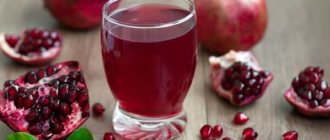It's hard to find a person who doesn't like to eat delicious food. Fragrant meat delicacies, spicy smoked meats, beautifully decorated sweets - this food just begs to be eaten. However, not all delicious foods are good for our body. People who have recently undergone surgery should be especially careful about their diet. Thus, experts recommend following a special diet after surgery to remove hemorrhoids. Proper nutrition will speed up recovery and promote:
- regular bowel function and establishing a clear bowel movement regime,
- a smooth and easy process of defecation, in which there is no trauma to the mucous membrane,
- normalization of blood circulation in the pelvic organs, which prevents the re-formation of hemorrhoids,
- restoration of the natural intestinal microflora, which leads to strengthening of overall immunity.
Your doctor will tell you how long you need to follow a diet after surgery to remove hemorrhoids. Typically, strict restrictions are imposed for 1-2 weeks. After the final recovery, it is enough to adhere to proper nutrition.
Methods of surgical treatment
- Desarterization of hemorrhoids - during the procedure, large vessels feeding the venous expansion are ligated. The pathological area, having lost its power source, gradually dies. If required, after disarterization, mucosal lifting and mucopexy are performed - additional suturing of the sagging mucous membrane with a special thread and tightening of the sutured area.
- Laser destruction (vaporization) is a minimally invasive method of removing pathological venous expansion under the influence of a thermal laser beam. The laser acts only on the affected tissue, heats the node, and evaporates the liquid from it. A small scar remains at the site of the removed extension, which prevents relapses. The advantage of the method is that the heat beam seals small blood vessels, this will avoid postoperative bleeding and rough scars on the mucous membrane.
- Thrombectomy from an external hemorrhoid with a laser - removal of a blood clot from the affected area of the vein, sometimes involving the venous wall. The laser machine allows for targeted surgery. The laser beam simultaneously seals the walls of the vein.
What will you have to give up?
The diet after surgery to remove hemorrhoids involves avoiding foods that increase gas formation and activate the processes of putrefaction and fermentation in the intestines. It is also not recommended to consume foods high in starch, excessive amounts of proteins and fats of animal origin. They adversely affect digestion and impair peristalsis. Excess table salt causes an increase in blood viscosity, stagnation in blood vessels and thrombus formation, which provokes a relapse. And extractive substances, spices and essential oils force the pancreas and stomach to work with redoubled force, while slowing down the motor function of the intestines.
After surgical treatment of hemorrhoids, you should avoid:
- baked goods and puff pastry products,
- fried and hard-boiled eggs,
- pasta,
- potatoes, bananas, mushrooms, legumes,
- chocolate and cakes with rich cream,
- fatty meats, fish and poultry,
- canned meat and fish,
- rich broths and so on.
How long does it take for hemorrhoids to heal after surgery?
Modern operations take place with minimal stress on the body. Laser surgery allows targeted action on the affected tissues and does not affect healthy areas of the mucosa. After laser exposure, there is no need to apply stitches, treat the wound, or apply dressings. The entire procedure takes 20–40 minutes, depending on the complexity of the case and the number of nodes. After the node is removed, the patient can return home. The proctologist will give recommendations on what painkillers to take and how to treat the anus in the postoperative period.
Hemorrhoids after laser surgery heal completely within one to two weeks. After just four to five days, you can increase your activity and return to your usual activities. If your job is sedentary, it will be important to take frequent breaks and stretches.
During the recovery period, it is necessary to eat properly so that the stool is moderately soft and regular. The basis of postoperative nutrition is oatmeal, buckwheat, barley, millet porridge with water, lean meat, fermented milk, thermally processed vegetables. It is advisable to eat 4-5 times a day in small portions. It is important to maintain an active drinking regime.
Permitted and prohibited products
The list of permitted products is quite large. From these you can create a varied, balanced menu:
- Fermented milk products with a low fat content are acceptable. Cheese can be eaten in small quantities, but it should be low-fat hard varieties. If the listed foods cause flatulence or diarrhea, they should be removed from the diet.
- Meat and poultry should be consumed lean. Veal, rabbit, chicken, and turkey are best suited.
- Be sure to eat lean fish, for example, cod, hake, pollock, and navaga.
- Vegetables should be those with fine fiber. These are broccoli and cauliflower. Dishes should be prepared from the following root vegetables: beets, turnips, carrots. In addition, pumpkin, zucchini, and lettuce are good options. Fruits should not cause gas. Kiwi, dogwood, and bananas are recommended. You can add dried fruits in small quantities.
- Herbal teas are allowed as drinks; chamomile, nettle, and yarrow are best. Let's say weakly brewed green tea. Dogwood compote helps a lot. You can take a honey solution. To do this, stir one tablespoon of honey in a glass of warm water.
- Bran bread goes in addition to main dishes.
- Among cereals, preference should be given to oatmeal, millet, buckwheat, and pearl barley. Rice can be used carefully; it has a fixing property.
The diet after hemorrhoidectomy involves limiting a number of foods and drinks that irritate the intestines and cause gas formation.
You will need to give up some foods
Prohibited:
- fatty fish,
- sweets;
- hot peppers;
- vegetables: onions, garlic, radish, white cabbage;
- citrus;
- milk;
- mushrooms;
- carbonated drinks;
- fresh apples in peel, pears;
- black, white bread;
- kvass;
- legumes;
- any canned food;
- strong tea, coffee;
- semolina;
- alcohol;
- pasta.
All of the foods listed should not be eaten for two months.
Knowing the lists of permitted and prohibited foods, you can create a balanced menu, thanks to which the recovery process will be successful, without complications.
How to prevent relapse
Laser surgery reduces the risk of recurrence of hemorrhoids to a minimum. But for a complete recovery you will have to change your lifestyle. It is important to establish regular bowel movements. A diet rich in dietary fiber and movement will help with this. Physical exercise will also help strengthen the venous walls.
Avoid heavy lifting if possible. If you have to sit a lot at work, take breaks every half hour: walk, do simple exercises. Another important aspect is personal hygiene. Choose soft, preferably damp toilet paper; if possible, wash with cool water. Switch to loose underwear made from natural fabrics.
The Clinic of Dr. Grishin employs professional proctologist surgeons. Our patients have access to all types of modern hemorrhoid removal. The clinic is equipped with a laser machine. The operation will take no more than half an hour, and you will go home. The postoperative period will pass quickly, with a minimum of inconvenience, and you will not fall out of your usual rhythm of life.
Approximate menu
You should follow nutritional rules, choose safe products and processing methods.
A few necessary recommendations for preparing and selecting dishes:
- The porridge should be liquid, viscous, and heavily boiled.
- Meat cannot be fried.
- Cook fish in the oven, in a double boiler, in a slow cooker, or cook. In this case, fat cannot be used.
- Vegetables must be heat treated and not fried. It is better to cook in a double boiler, bake, boil. You can return to raw vegetables after a diet by adding them gradually.
- Bread can be eaten with bran, from wholemeal flour, which contains a lot of fiber. Diet bread with fiber is suitable.
It is forbidden:
What methods should you cook?
After hemorrhoid removal, the diet should include healthy meals and enough water. An important aspect of therapeutic nutrition is the method of preparing foods.
It is recommended to prepare dishes using boiling, baking or steaming methods
Porridge needs to be cooked until fully cooked. It is allowed to steam the cereal in a thermos overnight without cooking. Oatmeal, wheat and buckwheat are considered the most useful after removing hemorrhoids of any degree. You should not completely give up rice, because this product contains essential microelements. Rice should be included in the diet in limited quantities, as it has a strengthening effect.
It is better to boil or steam vegetables and fruits during treatment immediately after removal of hemorrhoids. They should be consumed raw only after the stitches have completely healed, because the juice of some of them can cause irritation of the mucous membrane of the gastrointestinal tract.
It is better to cook fish and meat by baking with a small amount of vegetable oil or steaming. This method of cooking will help preserve the nutritional elements of food and satisfy the feeling of hunger.
Important! Frying, smoking and salting foods during the period after hemorrhoid surgery should be avoided. Eating such food during the rehabilitation period will prolong the healing process.
Diet of the first postoperative month
After a week, nutrition is gradually expanded.
Protein and carbohydrate foods are introduced in turn, achieving rapid removal of feces. Fiber is used to prevent constipation. The patient needs to learn the rules: to prevent the disease from returning, you need to move a lot, not lift weights, and eat right.
If there are no complications after hemorrhoids, complete healing of surgical wounds occurs in 5-6 weeks. The disease may return. The risk of anal fissures increases. The most strict diet is needed.
Importance of Diet
Any surgical intervention, regardless of the stage of hemorrhoids, is stressful for the body. There are several ways to surgically remove hemorrhoids. The operation can be closed or open. In the first case, wound healing and tissue restoration occurs faster. The rehabilitation period lasts from 3 to 5 weeks. With open surgery, it takes 6 to 8 weeks for the body to recover.
Throughout this period, the patient must maintain proper nutrition after removal of hemorrhoids. The diet helps prevent blood flow to the postoperative site, suture dehiscence, bleeding and other unpleasant complications.
The treatment menu is always aimed at preventing constipation, flatulence and diarrhea, since stool disturbances always negatively affect the healing period of wounds. That is why proctologists tirelessly repeat the importance of diet therapy, regardless of the type of surgical intervention and the patient’s well-being.
In what cases is surgery required?
Venous expansion causes the formation of hemorrhoidal cones-nodules, and if this pathology is not treated, then blood flow is disrupted, blood clots form, the walls of the veins swell and feces damage the affected areas.
And if at the beginning of the development of the disease you can get by with conservative treatment, then stages 3 and 4 require the intervention of a surgeon. Experts identify several conditions that require mandatory surgery:
- prolapse of internal hemorrhoids even without intense stress, for example, during coughing or sneezing;
- pinching of the lumps and the formation of blood clots in the veins of the rectum;
- increased frequency of heavy bleeding and the anal area.
Only the doctor determines what stage of the disease the patient has and decides whether removal of the nodes is required or whether drug treatment can be done.
Modern medicine offers both surgical and minimally invasive procedures. In the second case, the treatment is low-traumatic, performed in 15-20 minutes, does not require long-term recovery and has few side effects. However, it does not matter whether we are talking about the third or fourth degree of the disease, sometimes surgical intervention is still recommended.
After a person has the inflamed nodules removed, he will have to reconsider his diet. Experts recommend adhering to the third dietary table, but with some reservations.
The dietary table includes foods that have a positive effect on the functioning of the digestive tract
If complications arise after ligation of hemorrhoids
Despite the fact that the procedure for removing hemorrhoids is minimally invasive and safe, complications may occur after ligation. Most often they appear as a result of non-compliance with doctor’s recommendations and manifest themselves in the form of:
- Bleeding - as a result of injury to the node with feces or rejection of the pathological element;
- Discomfort in the rectal area (pain, irritation, feeling of pressure) - involvement of healthy tissues in the pathological process;
- Thrombosis of hemorrhoids - an error when performing ligation not on internal, but on external formations;
- Anal fissure - due to failure to use the toilet after ligation, which must be performed twice a day;
- Acute paraproctitis - the addition of a secondary infection due to injury to the hemorrhoidal node by solid intestinal contents;
- Recurrence of hemorrhoids;
- Spontaneous slipping of the latex ligature is increased physical effort due to lifting weights or pushing during bowel movements.
The most common complication when removing hemorrhoids is bleeding. The appearance of blood between acts of defecation after ligation is a negative symptom, indicating a complication that has arisen for any reason and requires mandatory consultation with a proctologist.
The most serious and dangerous is the first week after ligation, when the ring with the node comes off. Further, the likelihood of bleeding decreases significantly. Elimination of this frequent complication is carried out by prescribing conservative treatment, in the form of hemostatic suppositories, painkillers or electrocoagulation of the vessel.
Should ligation of hemorrhoids be performed as the disease progresses?
Proctology answers - definitely yes, in the absence of contraindications. This safe manipulation is guaranteed to eliminate the symptoms of hemorrhoids for an average of 4-6 years. If you follow all the doctor’s recommendations (diet, dosed physical activity, avoidance of bad habits), this period can increase to 7-8 years or more. Make an appointment
Additional recommendations
For a quick recovery during rehabilitation after surgery, the patient should adhere to the following recommendations:
- food and drinks should not be too hot or cold, this will negatively affect the digestion process. It is better to eat food warm;
- It is important to avoid any drinks during meals. This will lead to the fact that gastric juice will be diluted, which means that food will be less digestible. It is better to drink half an hour before or 30 minutes after meals;
- After a meal, you should not immediately engage in physical work or, conversely, lie down.
By following simple recommendations and adhering to a therapeutic diet, you can speed up the process of postoperative wounds, prevent recurrence of hemorrhoids, and quickly return to a full lifestyle.
Cooking recipes
Dietary food should not only be healthy, but also tasty. In the daily menu, the patient can use a variety of recipes for preparing dishes that will not cause harm to the body after excision of hemorrhoids.
Broccoli in cream sauce
To prepare the dish you will need:
- 500 g broccoli;
- low fat cream;
- 2 tablespoons flour;
- olive oil;
- small onion;
- salt.
Diet menu after hemorrhoid excision often includes broccoli
Wash the broccoli, separate it into florets, and steam until the vegetable softens. In a frying pan with a thick bottom, sauté the chopped onion, pour a glass of cream over it, and simmer for 15 minutes. Add flour, salt, olive oil to the sauce, simmer for another 5 minutes, remove from heat. Pour the sauce over the broccoli and serve warm or cold.
Chicken cutlets with zucchini
The recipe includes the following products:
- 200 g chicken breast;
- small zucchini;
- onion;
- egg;
- flour;
- salt.
Grind the chicken meat in a meat grinder or chop it very finely. Peel the zucchini, finely chop or grate it, squeeze out excess liquid, mix with minced chicken. Add egg, flour, salt to the resulting mass. Lightly fry the cutlets in olive oil, then steam until cooked.
Pumpkin and apple puree
To prepare you will need:
- 200 g pumpkin;
- 2 large apples;
- olive oil;
- 2 tablespoons of sour cream with a fat content of 1.5%;
- salt.
Apple and pumpkin puree
Rinse apples and pumpkin well, peel, and grind through a meat grinder or blender. Bring the resulting mass to a boil and keep on low heat for about a quarter of an hour. Boil the cream and olive oil separately, then mix the products and boil again for 10 minutes. Salt the puree to taste.
